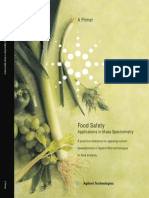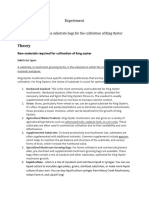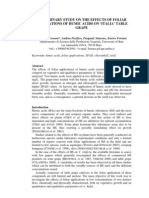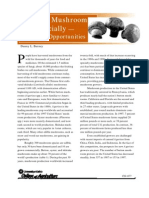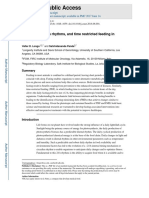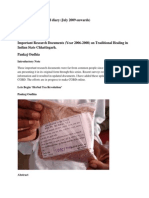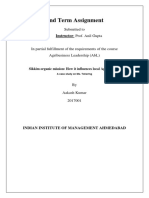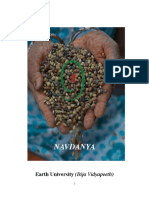Winter Growing
Winter Growing
Uploaded by
eioCopyright:
Available Formats
Winter Growing
Winter Growing
Uploaded by
eioOriginal Description:
Copyright
Available Formats
Share this document
Did you find this document useful?
Is this content inappropriate?
Report this DocumentCopyright:
Available Formats
Winter Growing
Winter Growing
Uploaded by
eioCopyright:
Available Formats
A DOOR INTO SUMMER
By Gwen O’Reilly
“Can’t be done, huh?” That was Carol Ford and Chuck Waibel’s response when
they were told they couldn’t grow vegetables in winter in windy, west central
Minnesota without incurring prohibitive fuel costs.
O
ne fall, after the CSA program they had be-
longed to had ended, Carol and Chuck
thought, “Somebody needs to do something
about fresh vegetables in the winter!” The project
started when the pronoun shifted to “We” need to
do something.
Carol is a Master Gardener and had seen many
greenhouse designs in her horticultural career; Chuck
had taught courses such as “Social and Ethical Im-
plications of Technology.” They considered the de-
mand for local food in the context of existing energy
technology and asked themselves why wasn’t anyone
doing this. They took a Farm Beginnings course from
a local Land Stewardship Project, developed a busi-
ness plan and got a loan.
Now, they run a winter CSA. That’s right. They
decided that a CSA was too good an idea to use only
part of the year. They had considered Eliot
Coleman’s four season approach, but realized a hoop
house was unlikely to withstand the –40OC wind chill
of their prairie home. So, they came up with a de-
sign for a passive solar greenhouse to grow greens
and cool season crops throughout the winter. They
started Garden Goddess Produce, an 18-member
CSA, and now grow storage vegetables throughout
the summer months to supplement the star attrac-
tion: a wide variety of fresh greens and brassicas.
Chuck and Carol had several goals in mind when
they designed their 16 by 22 foot (roughly 5 by 7 Crops are grown in a series of suspended eaves-
metre) greenhouse. Foremost, of course, it had to troughs that make efficient use of the vertical space.
withstand winters in northern Minnesota. It had to
use very little energy and require only minimal sup-
plemental heat. At least part of their motivation was because they embarked on this project with the inten-
to address concerns about climate change and Peak tion to share their model with other northern com-
Oil, while producing good food and supporting the munities. A business advisor cautioned them to patent
local economy. or trademark their ideas, but Chuck explained that
The greenhouse had to be easy and relatively inex- everything they’ve done is a creative combination of
pensive to duplicate using “off the shelf ” materials, information in the public domain, and they’d like it to
8 – Summer 2010 The Canadian Organic Grower www.cog.ca
stay that way. He says he’s a
Schumacher (Small is Beautiful)
kind of guy.
Their growing schedule, which
they squeeze in between other em-
ployment, now competes with nu-
merous requests for tours and
“The door into summer” leads to a growing season no matter what
talks, which they willingly provide. month it is.
The challenge? To find time to ex-
pand their enterprise to include The foundation is excavated tures, and use fans and vents for
aquaculture, a larger greenhouse, four feet (1.2 m) into the ground ventilation. In the coldest or grey-
and a cold storage unit to accom- to bring it below the frost line and est weather, they use a propane
modate their needs, as well as is insulated with Styrofoam. Grow- heater to keep the temperature up,
those of other local growers. Oh, ing temperatures are maintained but burn less than $100 of fuel in
and maybe a publishing house for by a simple solar heat pump, a season. The supplementary heat
local food resources. which consists of loops of perfo- comes on at 40OF (6OC), prima-
They built the structure off the rated drainage pipe buried in sev- rily to keep the water pipes from
back of their garage which pro- eral feet of large gravel and rock freezing. The crops are actually
tects its north wall, and also makes that acts as thermal mass. Grow- able to withstand lower tempera-
it easy to load produce into their ing beds have been built on top. tures.
vehicle. The surfaces with direct Lengths of black stovepipe run Crops are grown in beds and
and maximum exposure to the sun through the topside of the green- in a series of suspended eaves-
are glazed with double-walled house and a couple of small fans troughs that make efficient use of
polycarbonate panels, and all blow hot air from the stovepipe the vertical space.
other walls are well insulated. The into the drainage pipe in the rock Carol says they wanted to see
glazing is angled steeply enough mass during warm days. The what they could produce with as
to capture most of the winter sun’s stored warmth in the rock slowly few inputs as possible, which elimi-
radiation at as close to a 90 de- makes its way up through the floor nated the idea of fruiting vegeta-
gree angle as possible. Everything at night. bles which need higher temp-
is painted flat white for maximum Chuck and Carol use a few wa- eratures and longer day lengths.
reflection. ter barrels to moderate tempera- They didn’t want to use supple-
mental lighting because it would
increase energy use, cost and tech-
nological complexity. They dis-
covered that many varieties of
vegetables will grow in a cool
greenhouse without artificial lights
and that winter greens are super-
ior to those grown in summer.
These brassicas and dark greens
are most beneficial in our winter
diets.
Carol worries about lower light
levels causing increased nitrate
levels in the winter crops. To com-
pensate, she adjusts soil nitrogen
levels by changing the organic fer-
tilizer in the planters’ soil mix.
The surfaces with direct and maximum exposure to the sun are glazed During mid-winter seeding, Carol
with double-walled polycarbonate panels. uses half the regular amount of
www.cog.ca Our Nature is Organic Summer 2010 – 9
bloodmeal* in the fertilizer mix. ferent suites of varieties work best addiction to kale, collards and
After spring equinox, she uses the for each phase of the colder chard as evidence that people are
full amount. She says cutting back months. “just one recipe away from being
the bloodmeal “has not affected The greenhouse is so energy- converts.”
yields, but hopefully cuts down on efficient that it is not really usable Best of all, no matter how blus-
the amount of nitrogen the plants in summer—it is just too hot. tery the day, it is always lush and
have to respirate, so green inside their invention.
on cloudy days it’s Chuck and Carol call the entrance
less likely they’ll get A high-temperature fallow into the greenhouse “the door into
a nitrate build-up in season keeps down the insect summer.” The name comes from
their leaves.” the title of a Robert Heinlein
She is looking for
population and lets Carol novel about a cat who, one winter,
a research chemist to and Chuck concentrate kept insisting his owner let him out
assess if there is any on their outdoor garden. the particular door that leads to
difference, better or pleasant weather. Chuck says
worse, between her they’ve also been checking un-
produce and that in the grocery Carol takes advantage of this by tried doors, but unlike the cat,
store. letting the soil dry out and solar- have found the one that does lead
Their only inputs are organic ize. A high-temperature fallow sea- to summer. Or, at least a taste of
soil amendments and parasitic son keeps down the insect it.
wasps for aphid control, but Chuck population and lets Carol and
You can find out more about
and Carol feel it is too expensive Chuck concentrate on their out-
Chuck and Carol and their green-
to certify such a small operation. door garden which is filled with
house at their website: www.
Their CSA members are primarily winter vegetables for the CSA.
gardengoddessenterprises.com.
interested in local food, and also Carol says she has tried growing
You can also find information
trust that the couple will not be every root crop available to “keep
about their inspiring book: The
heavy handed with any pesticide, it interesting” over the winter
Northlands Winter Greenhouse
organic or otherwise. storage months, and distributes a
Manual: a low-tech solution to
Carol has found that winter newsletter with recipes to help cus-
vegetable production in cold cli-
growing is best divided into three tomers make use of novel items.
mates. Carol Ford and Chuck
seasons: diminishment; solstice Even so, her customers report that
Waibel. Garden Goddess Publica-
and expansion. She has found dif- some roots are just too unfamil-
tions. 2009.
iar—salsify, scorzonera and winter
* The Canadian organic standards al- radishes have not been big hits. Photo credits: Chuck Waibel of
low blood meal only if it is sterilized. But she cites her newly developed Garden Goddess Enterprises
Your Organic Feed and Farm Supplies
Field Crop Marketing:
√ Forward contracts for food and feed crops.
√ Soybeans, buckwheat, cereals, corn, peas.
Organic Farm & GardenSupplies:
√ mixed feed for all your farm livestock.
√ livestock supplements and health products.
Berwick Ontario K0C 1G0 √ soil amendments; seed; pest control products.
Toll Free: 1-877-984-0480
A Dealer near you in Ont, Qué & the Maritimes.
www.homesteadorganics.ca
10 – Summer 2010 The Canadian Organic Grower www.cog.ca
WHY LET WINTER
STOP YOU?
By Gwen O’Reilly
H
ey, we’re Canadian, right? We’re not
afraid of a little cold weather, espe-
cially here in the winter sunshine
capital of Canada. Sure, lows in the minus
30s and even 40s are common, but that
shouldn’t stop a truly intrepid gardener.
When Leo Hunnakko read that Northwest-
ern Ontario receives 340 hours of sunshine
in December, January and February, he won-
dered why there weren’t solar collectors all
around the area. He started to research the
The greenhouse has a series of solar water
heaters on the roof that heat liquid which then
runs through a hot water tank.
round greenhouse, aptly named “GH365,”
was built in the summer and fall of 2009 on
property in Nolalu, Ontario, that his family
homesteaded in the 1930s.
He plants various crops throughout the
The south-facing wall, angled at 36 degrees, is glazed with
winter (greens, radishes, onions, broccoli, to-
argon-filled double pane glass windows.
matoes and peppers). One morning, he was
planting in the greenhouse while the outdoor
design of cold climate, year-round solar thermal temperature was –34OC.
greenhouses, and found very few resources. He de- Leo considers himself an organic gardener, and
cided to undertake a feasibility study to see if it was draws inspiration from the self sufficiency of his par-
possible to operate a year-round greenhouse using ents’ generation. He remembers that his family
only supplementary heat and minimal electrical con- stored root vegetables and preserves made from
sumption. gathered fruit in a root cellar, and relied on a veg-
Leo developed a solar greenhouse design, in con- etable garden in the summer. They kept milking cows
sultation with various experts and with funding from and chickens. His father hunted for moose and deer,
the National Research Council and the Northern On- while he and his brothers caught speckled trout in a
tario Heritage Fund. The prototype of the year- nearby creek. Leo sees his greenhouse as a way of
12 – Summer 2010 The Canadian Organic Grower www.cog.ca
returning to this tradition of self
reliance.
The 18 by 22 foot (5.5 by 6.7
m) structure has a series of solar
water heaters on the roof that heat
liquid which then runs through a
hot water tank. Hot liquid is cir-
culated through tubes in the floor,
root zones and the north wall,
which is filled with sand. Thermo-
stats regulate circulating pumps
and the water tank has an electric
back-up that will kick in after sev-
eral overcast days, or on exces-
sively cold nights. He has also
installed a couple of baseboard
heaters (just in case) and a large
commercial fan for ventilation.
Leo has been impressed by last
winter’s tomato crop, but notes The greenhouse is home to various crops throughout the winter,
that cold-sensitive crops require including greens, radishes, onions, broccoli, tomatoes and peppers.
careful maintenance of tempera-
ture range. It is a balancing act to at 36 degrees, is glazed with ar- second version, and would even-
do this and keep electrical con- gon-filled double pane glass win- tually like to see his greenhouse
sumption low. In March, the dows, purchased second-hand used in First Nations and other
GH365 used 168 kWh of power, from a commercial greenhouse rural and remote communities to
at a cost of $20.16. operator. Thermal blinds are used improve their local food security.
The building is well insulated, to keep the heat in on long winter But in the mean time, there’s
and the south-facing wall, angled nights. Leo is already designing a spring salsa to be made!
You can see pictures of the
greenhouse and the construction
process at Leo’s website at
www.greenhouse365.ca.
Gwen O’Reilly had to tear down her
beloved greenhouse this year to make
way for house renovations, but
serendipity (and a food security
conference) brought her to workshops
presented by Leo Hunnakka, and
Carol Ford and Chuck Waibel. She
hopes to start digging the new
foundation by fall, and thinks her
writing may suffer when she has her
own “Door into summer.”
Photos courtesy of Leo Hunnakko.
One morning, Leo Hunnakko was planting in the greenhouse while the
outdoor temperature was –34OC.
www.cog.ca Our Nature is Organic Summer 2010 – 13
You might also like
- High Times - November 2023Document84 pagesHigh Times - November 2023miwoga7814Noch keine Bewertungen
- HT18 32.1 Cannabis Program SheetDocument2 pagesHT18 32.1 Cannabis Program SheetThomas DylanNoch keine Bewertungen
- Morel CultivationDocument1 pageMorel Cultivationvas2000Noch keine Bewertungen
- High PPFD Cultivation GuideDocument17 pagesHigh PPFD Cultivation GuideDavidNoch keine Bewertungen
- Floracopeia Essential Oil EbookDocument61 pagesFloracopeia Essential Oil EbookOana Algasovschi100% (3)
- Food IcpmsDocument82 pagesFood IcpmsJose GarciaNoch keine Bewertungen
- King Oyster Substrate (PreparationDocument4 pagesKing Oyster Substrate (PreparationshashsrdNoch keine Bewertungen
- Bio Aquatic Bacteria BoostDocument4 pagesBio Aquatic Bacteria Boost21smithNoch keine Bewertungen
- Arsen Gasparyan - Cultivation Technology of Oyster MushroomDocument19 pagesArsen Gasparyan - Cultivation Technology of Oyster Mushroomjeleel44Noch keine Bewertungen
- Hydroponics ModelsDocument10 pagesHydroponics ModelsSagnik DamNoch keine Bewertungen
- Growing Aztekium From SeedDocument1 pageGrowing Aztekium From SeedOgofNoch keine Bewertungen
- Pepper Diseases - A Practical Guide To Identification & ControlDocument35 pagesPepper Diseases - A Practical Guide To Identification & Control19crysti100% (6)
- Greenhouse Power & CO FertilisationDocument4 pagesGreenhouse Power & CO FertilisationtimgourNoch keine Bewertungen
- Beneficial Bacteria of Agricultural ImportanceDocument12 pagesBeneficial Bacteria of Agricultural ImportanceXevin MoreiraNoch keine Bewertungen
- Paddy Straw Mushroom ProdnDocument44 pagesPaddy Straw Mushroom ProdnmiradewiNoch keine Bewertungen
- Aquaponics STEMDocument12 pagesAquaponics STEMshawcj1978Noch keine Bewertungen
- Deep Water Culture SystemDocument8 pagesDeep Water Culture SystemganasunebaNoch keine Bewertungen
- Cultivation of Pleurotus Ostreatus and Other Edible MushroomsDocument17 pagesCultivation of Pleurotus Ostreatus and Other Edible MushroomssiripornhassarangseeNoch keine Bewertungen
- Comparative Study On Effect of Different Substrates On Yield Performance of Oyster MushroomDocument7 pagesComparative Study On Effect of Different Substrates On Yield Performance of Oyster Mushroomscience JournalsNoch keine Bewertungen
- Chanterelle Mushroom IdentificationDocument4 pagesChanterelle Mushroom IdentificationAlarm GuardiansNoch keine Bewertungen
- Cubensis History Taxonomy ListDocument10 pagesCubensis History Taxonomy ListJOSE DANIEL SANTACRUZ LONDONONoch keine Bewertungen
- Corra 2016Document15 pagesCorra 2016Benito, BodoqueNoch keine Bewertungen
- Oyster Mushroom Cultivation in Northern ThailandDocument8 pagesOyster Mushroom Cultivation in Northern ThailandAnonymous HXLczq3Noch keine Bewertungen
- Garden Seed Handbook Part 31Document5 pagesGarden Seed Handbook Part 31gezarolNoch keine Bewertungen
- Propagation of Rose (Rosa Hybrida L.) Under Tissue Culture TechniqueDocument5 pagesPropagation of Rose (Rosa Hybrida L.) Under Tissue Culture TechniqueEmilia NatashaNoch keine Bewertungen
- MycofabricationofMycelium BasedLeatherfromBrownDocument20 pagesMycofabricationofMycelium BasedLeatherfromBrownyoussef ben salemNoch keine Bewertungen
- Package of Practices On CauliflowerDocument14 pagesPackage of Practices On CauliflowertummalaajaybabuNoch keine Bewertungen
- Caveat of Truffle FarmingDocument2 pagesCaveat of Truffle FarmingDeepak Kumar KhadkaNoch keine Bewertungen
- Ergot The Genus Claviceps (Medicinal and Aromatic Plants - Industrial Profiles) PDFDocument501 pagesErgot The Genus Claviceps (Medicinal and Aromatic Plants - Industrial Profiles) PDFMarius SantimbreanNoch keine Bewertungen
- Oyester Mushroom CultivationDocument8 pagesOyester Mushroom CultivationkibriyaNoch keine Bewertungen
- Seeds From Italy 2013 CatalogDocument25 pagesSeeds From Italy 2013 CatalogjsilomanNoch keine Bewertungen
- Fermented Mushroom PDFDocument8 pagesFermented Mushroom PDFmedelinNoch keine Bewertungen
- Uofahydroponicnotes PDFDocument130 pagesUofahydroponicnotes PDFBashar DaoudNoch keine Bewertungen
- A Study of The Poultry Genetics Industry: Presented byDocument16 pagesA Study of The Poultry Genetics Industry: Presented byRohan SethNoch keine Bewertungen
- What's Happening in The World of AquaponicsDocument6 pagesWhat's Happening in The World of AquaponicsLindaM857Noch keine Bewertungen
- Mud Culture: Training Manu Crab Breeding andDocument145 pagesMud Culture: Training Manu Crab Breeding andvlabdulazeemNoch keine Bewertungen
- FAO Forage Profile - UgandaDocument17 pagesFAO Forage Profile - UgandaAlbyziaNoch keine Bewertungen
- Plant Tissue Culture ProtocolDocument7 pagesPlant Tissue Culture ProtocolMa-anJaneDiamosNoch keine Bewertungen
- Growing Guide Radishes TurnipsDocument8 pagesGrowing Guide Radishes TurnipsharleyNoch keine Bewertungen
- Soil BacteriaDocument2 pagesSoil Bacteriaani4 samNoch keine Bewertungen
- Maitake and Morels CultureDocument95 pagesMaitake and Morels CulturejakoknoxNoch keine Bewertungen
- Effect of Humic Acid On GrapeDocument6 pagesEffect of Humic Acid On GrapekongclNoch keine Bewertungen
- Aqua Ponic SDocument3 pagesAqua Ponic SPraba KaranNoch keine Bewertungen
- Agricultural Sciences Mushroom Cultivation (AGA - 453) B.Sc. (Hons.), B.Sc. Integrated MBADocument7 pagesAgricultural Sciences Mushroom Cultivation (AGA - 453) B.Sc. (Hons.), B.Sc. Integrated MBAMahendra paudel Paudel100% (1)
- Introducing Mushroom Biotechnology in Goa-By Nandkumar KamatDocument9 pagesIntroducing Mushroom Biotechnology in Goa-By Nandkumar Kamatnandkamat100% (2)
- Sample SOP - PropagationDocument4 pagesSample SOP - PropagationFunHunterNoch keine Bewertungen
- Basics Container Gardening VegetablesDocument7 pagesBasics Container Gardening VegetablesBlair CarterNoch keine Bewertungen
- Recent Advances in Cordyceps Sinensis Polysaccharides Mycelial FermentationDocument16 pagesRecent Advances in Cordyceps Sinensis Polysaccharides Mycelial FermentationNguyễn Hữu ToànNoch keine Bewertungen
- 1Document6 pages1Rajdeep RajdipNoch keine Bewertungen
- Application of Open Garden Sensor On Hydroponic Maintenance ManagementDocument9 pagesApplication of Open Garden Sensor On Hydroponic Maintenance ManagementpintuNoch keine Bewertungen
- RiceDocument15 pagesRicechang27100% (1)
- Hydroponics ProjectDocument60 pagesHydroponics ProjectLateef TosinNoch keine Bewertungen
- Growing Mushrooms Commercially: - Risks and OpportunitiesDocument8 pagesGrowing Mushrooms Commercially: - Risks and OpportunitiesSharad BhutoriaNoch keine Bewertungen
- Automated Mushroom Cultivation and Maintenance System in A Plastic Box Using Solar PowerDocument4 pagesAutomated Mushroom Cultivation and Maintenance System in A Plastic Box Using Solar PowerGlaiza LacsonNoch keine Bewertungen
- Chapter 1 Oyster MushroomsDocument17 pagesChapter 1 Oyster MushroomsIsabel Katrina CajuguiranNoch keine Bewertungen
- Diseases, Insects and Spraying Fruit Trees in the OrchardFrom EverandDiseases, Insects and Spraying Fruit Trees in the OrchardNoch keine Bewertungen
- The Ultimate Beginner’s Guide to Homestead Gardening: Your Next Step to Self-SufficiencyFrom EverandThe Ultimate Beginner’s Guide to Homestead Gardening: Your Next Step to Self-SufficiencyNoch keine Bewertungen
- Truffiæmffitutgæw: WtuçaqtuæffiDocument30 pagesTruffiæmffitutgæw: WtuçaqtuæffieioNoch keine Bewertungen
- Electroculture of Tomato Plants in A Commercial Hydroponics GreenhouseDocument6 pagesElectroculture of Tomato Plants in A Commercial Hydroponics GreenhouseeioNoch keine Bewertungen
- Can 2016 0009Document12 pagesCan 2016 0009eioNoch keine Bewertungen
- Ceres GAHT System BrochureDocument4 pagesCeres GAHT System BrochureeioNoch keine Bewertungen
- HHS Public Access: Fasting, Circadian Rhythms, and Time Restricted Feeding in Healthy LifespanDocument24 pagesHHS Public Access: Fasting, Circadian Rhythms, and Time Restricted Feeding in Healthy LifespaneioNoch keine Bewertungen
- Yung Flutes GuideDocument36 pagesYung Flutes Guideeio100% (1)
- Permaculture Magazine - Practical Solutions For Self-RelianceDocument17 pagesPermaculture Magazine - Practical Solutions For Self-RelianceeioNoch keine Bewertungen
- Learn Permaculture Design For Free - Permaculture MagazineDocument2 pagesLearn Permaculture Design For Free - Permaculture MagazineeioNoch keine Bewertungen
- Per Serving (Including Side Dish) : 376 Calories / 49 G Carbs / 13 GDocument2 pagesPer Serving (Including Side Dish) : 376 Calories / 49 G Carbs / 13 GeioNoch keine Bewertungen
- Final Draft-Nestor B. UbaldeDocument27 pagesFinal Draft-Nestor B. UbaldeNestor pau ubaldeNoch keine Bewertungen
- Nazir A Ganai: Skuast-KDocument29 pagesNazir A Ganai: Skuast-KGaurav BhattalNoch keine Bewertungen
- Green SkillsDocument4 pagesGreen SkillsHuda ShahNoch keine Bewertungen
- Jasmine Rice: Adapting Rice Farming To Climate Change in Northeast ThailandDocument12 pagesJasmine Rice: Adapting Rice Farming To Climate Change in Northeast ThailandOxfamNoch keine Bewertungen
- Overview of Compost Tea Use in New South Wales, AustraliaDocument32 pagesOverview of Compost Tea Use in New South Wales, AustraliaPennsylvania Association for Sustainable AgricultureNoch keine Bewertungen
- Traditional Healing in Indian State ChhattisgarhDocument251 pagesTraditional Healing in Indian State Chhattisgarhharsha573201Noch keine Bewertungen
- RAWEDocument94 pagesRAWEAbhay SirohiNoch keine Bewertungen
- PayDirt Farming and Gardening With CompostsDocument202 pagesPayDirt Farming and Gardening With CompostsTeo100% (1)
- Aakash Sikkim Organic MissionDocument8 pagesAakash Sikkim Organic MissionAakash KashyapNoch keine Bewertungen
- 51-Article Text-49-1-10-20181006 PDFDocument10 pages51-Article Text-49-1-10-20181006 PDFNadiaumiNoch keine Bewertungen
- Organic Potato Production GuideDocument83 pagesOrganic Potato Production GuideRajesh KumarNoch keine Bewertungen
- FOCARS ReadingMaterialDocument578 pagesFOCARS ReadingMaterialkuldeepdeepikaNoch keine Bewertungen
- Navdanya Visitor GuideDocument29 pagesNavdanya Visitor GuideevergreenmanuNoch keine Bewertungen
- Strategi Pengembangan Usahatani Kangkung 75cf0672Document14 pagesStrategi Pengembangan Usahatani Kangkung 75cf0672danyadoenNoch keine Bewertungen
- Susan PrajapatiDocument50 pagesSusan PrajapatiSiddhartha PrajapatiNoch keine Bewertungen
- NAFEDDocument13 pagesNAFEDSalil Shrivastava100% (2)
- Organic Farming Cert - RusituDocument11 pagesOrganic Farming Cert - RusituMichaelNoch keine Bewertungen
- Kurukshetra November 2013 PDFDocument50 pagesKurukshetra November 2013 PDFAVENKATESHNoch keine Bewertungen
- CERES Guidelines For Green Purchasing PolicyDocument12 pagesCERES Guidelines For Green Purchasing PolicycaptmadhunairNoch keine Bewertungen
- Model Bankable Project-Floriculture SamDocument16 pagesModel Bankable Project-Floriculture Samsamuvel samNoch keine Bewertungen
- Windrow Composting Framework Operations Plan and Design DrawingsDocument38 pagesWindrow Composting Framework Operations Plan and Design DrawingsKrishna NiraulaNoch keine Bewertungen
- A8 Venky Final BPLANDocument28 pagesA8 Venky Final BPLANharshit sachdevaNoch keine Bewertungen
- Animal FarmingDocument16 pagesAnimal FarmingAnonymous dLIq7U3DKzNoch keine Bewertungen
- Agro Technique of Selected Med PlantDocument131 pagesAgro Technique of Selected Med PlantsbsatyajitNoch keine Bewertungen
- Sareko: The Bio Food Box - Made in SenegalDocument66 pagesSareko: The Bio Food Box - Made in SenegalProWorksNoch keine Bewertungen
- Apendix and CasesDocument302 pagesApendix and CaseschelintiNoch keine Bewertungen
- NYTC 2014 Batch 1 Final ReportDocument31 pagesNYTC 2014 Batch 1 Final ReportManoa Nagatalevu TupouNoch keine Bewertungen
- CLM Sample Oap NC IIDocument1 pageCLM Sample Oap NC IILouie DelarasNoch keine Bewertungen
- G-11 Organic AgriDocument2 pagesG-11 Organic AgriDanzel SugseNoch keine Bewertungen





